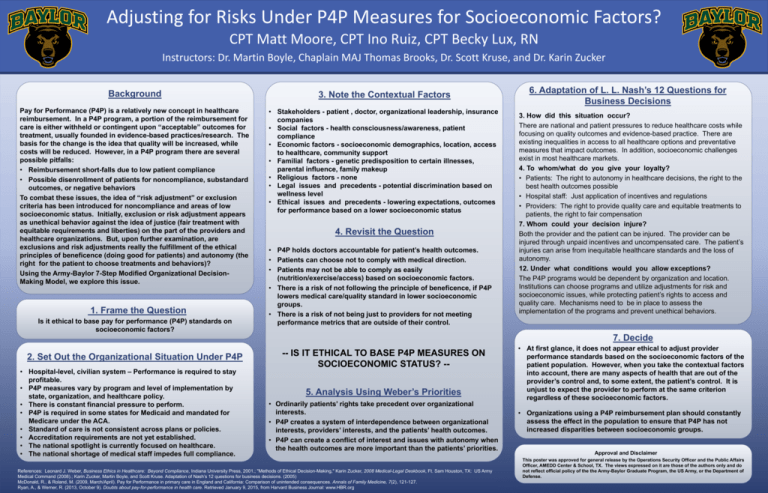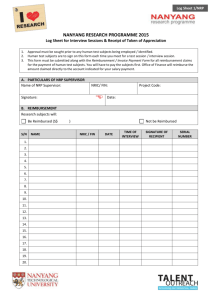Adjusting for Socioeconomic Risk Factors Under Pay-For
advertisement

Adjusting for Risks Under P4P Measures for Socioeconomic Factors? CPT Matt Moore, CPT Ino Ruiz, CPT Becky Lux, RN Instructors: Dr. Martin Boyle, Chaplain MAJ Thomas Brooks, Dr. Scott Kruse, and Dr. Karin Zucker Background 3. Note the Contextual Factors Pay for Performance (P4P) is a relatively new concept in healthcare reimbursement. In a P4P program, a portion of the reimbursement for care is either withheld or contingent upon “acceptable” outcomes for treatment, usually founded in evidence-based practices/research. The basis for the change is the idea that quality will be increased, while costs will be reduced. However, in a P4P program there are several possible pitfalls: • Reimbursement short-falls due to low patient compliance • Possible disenrollment of patients for noncompliance, substandard outcomes, or negative behaviors To combat these issues, the idea of “risk adjustment” or exclusion criteria has been introduced for noncompliance and areas of low socioeconomic status. Initially, exclusion or risk adjustment appears as unethical behavior against the idea of justice (fair treatment with equitable requirements and liberties) on the part of the providers and healthcare organizations. But, upon further examination, are exclusions and risk adjustments really the fulfillment of the ethical principles of beneficence (doing good for patients) and autonomy (the right for the patient to choose treatments and behaviors)? Using the Army-Baylor 7-Step Modified Organizational DecisionMaking Model, we explore this issue. • Stakeholders - patient , doctor, organizational leadership, insurance companies • Social factors - health consciousness/awareness, patient compliance • Economic factors - socioeconomic demographics, location, access to healthcare, community support • Familial factors - genetic predisposition to certain illnesses, parental influence, family makeup • Religious factors - none • Legal issues and precedents - potential discrimination based on wellness level • Ethical issues and precedents - lowering expectations, outcomes for performance based on a lower socioeconomic status 1. Frame the Question Is it ethical to base pay for performance (P4P) standards on socioeconomic factors? 4. Revisit the Question • P4P holds doctors accountable for patient’s health outcomes. • Patients can choose not to comply with medical direction. • Patients may not be able to comply as easily (nutrition/exercise/access) based on socioeconomic factors. • There is a risk of not following the principle of beneficence, if P4P lowers medical care/quality standard in lower socioeconomic groups. • There is a risk of not being just to providers for not meeting performance metrics that are outside of their control. 6. Adaptation of L. L. Nash’s 12 Questions for Business Decisions 3. How did this situation occur? There are national and patient pressures to reduce healthcare costs while focusing on quality outcomes and evidence-based practice. There are existing inequalities in access to all healthcare options and preventative measures that impact outcomes. In addition, socioeconomic challenges exist in most healthcare markets. 4. To whom/what do you give your loyalty? • Patients: The right to autonomy in healthcare decisions, the right to the best health outcomes possible • Hospital staff: Just application of incentives and regulations • Providers: The right to provide quality care and equitable treatments to patients, the right to fair compensation 7. Whom could your decision injure? Both the provider and the patient can be injured. The provider can be injured through unpaid incentives and uncompensated care. The patient’s injuries can arise from inequitable healthcare standards and the loss of autonomy. 12. Under what conditions would you allow exceptions? The P4P programs would be dependent by organization and location. Institutions can choose programs and utilize adjustments for risk and socioeconomic issues, while protecting patient’s rights to access and quality care. Mechanisms need to be in place to assess the implementation of the programs and prevent unethical behaviors. 7. Decide 2. Set Out the Organizational Situation Under P4P • Hospital-level, civilian system – Performance is required to stay profitable. • P4P measures vary by program and level of implementation by state, organization, and healthcare policy. • There is constant financial pressure to perform. • P4P is required in some states for Medicaid and mandated for Medicare under the ACA. • Standard of care is not consistent across plans or policies. • Accreditation requirements are not yet established. • The national spotlight is currently focused on healthcare. • The national shortage of medical staff impedes full compliance. -- IS IT ETHICAL TO BASE P4P MEASURES ON SOCIOECONOMIC STATUS? -5. Analysis Using Weber’s Priorities • Ordinarily patients’ rights take precedent over organizational interests. • P4P creates a system of interdependence between organizational interests, providers’ interests, and the patients’ health outcomes. • P4P can create a conflict of interest and issues with autonomy when the health outcomes are more important than the patients’ priorities. References: Leonard J. Weber, Business Ethics in Healthcare: Beyond Compliance, Indiana University Press, 2001.; "Methods of Ethical Decision-Making," Karin Zucker, 2008 Medical-Legal Deskbook, Ft. Sam Houston, TX: US Army Medical Command (2008).; Karin Zucker, Martin Boyle, and Scott Kruse. Adaptation of Nash’s 12 questions for business decisions. (2005) McDonald, R., & Roland, M. (2009, March/April). Pay for Performance in primary care in England and California: Comparison of unintended consequences. Annals of Family Medicine, 7(2), 121-127. Ryan, A., & Werner, R. (2013, October 9). Doubts about pay-for-performance in health care. Retrieved January 9, 2015, from Harvard Business Journal: www.HBR.org • At first glance, it does not appear ethical to adjust provider performance standards based on the socioeconomic factors of the patient population. However, when you take the contextual factors into account, there are many aspects of health that are out of the provider’s control and, to some extent, the patient’s control. It is unjust to expect the provider to perform at the same criterion regardless of these socioeconomic factors. • Organizations using a P4P reimbursement plan should constantly assess the effect in the population to ensure that P4P has not increased disparities between socioeconomic groups. Approval and Disclaimer This poster was approved for general release by the Operations Security Officer and the Public Affairs Officer, AMEDD Center & School, TX. The views expressed on it are those of the authors only and do not reflect official policy of the the Army-Baylor Graduate Program, the US Army, or the Department of Defense.





